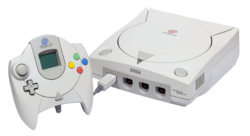| |
| Video games |
|---|

This is a list of video games for the Dreamcast video game console that have sold or shipped at least 250,000 copies or more. Sega launched the Dreamcast in Japan on November 27, 1998, in North America on September 9, 1999, and in Europe on October 14, 1999. [1] [2] In North America, first day sales for the console reached $100 million dollars. [3]
Contents
On January 31, 2001, Sega announced that they would be transitioning to third-party developers and publishing games for Nintendo, Sony, and Microsoft's consoles, while the Dreamcast was discontinued on March 31, 2001. [4]
According to PC Data, the top ten best-selling Dreamcast Games in 2000 were, in order: NFL 2K1 , Crazy Taxi , NBA 2K1 , Shenmue , Resident Evil – Code: Veronica , NHL 2K , World Series Baseball 2K1 , Sonic Adventure , NBA 2K and Tony Hawk's Pro Skater 2 . [5] At 2.5 million copies, Sonic Adventure is the best-selling Dreamcast game.
According to GamePro , the Dreamcast's game library was celebrated. [6] In January 2000, Electronic Gaming Monthly wrote that "with triple-A stuff like Soul Calibur, NBA 2K, and soon Crazy Taxi to kick around, we figure you're happy you took the 128-bit plunge". [7] In a retrospective, PC Magazine referred to Dreamcast's "killer library" and said that Sega's creative influence and visual innovation had been at its peak. [8]